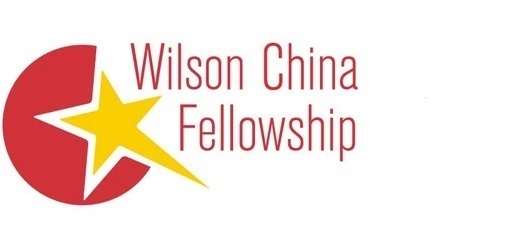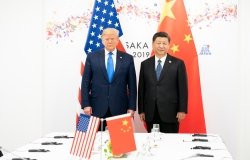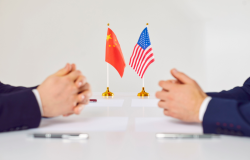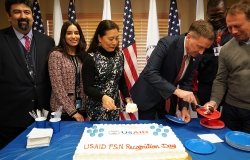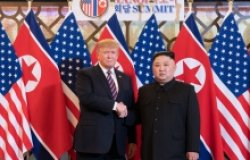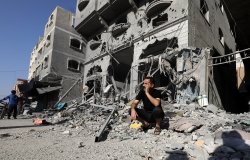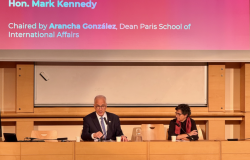Nuclear Diplomacy with North Korea and Iran: From Transformational to Transactional
“Nuclear diplomacy with both North Korea and Iran is at an inflection point, at which the limits of the transformational approach are evident,” writes Robert Litwak. The Trump administration, he says, should pivot to the transactional.
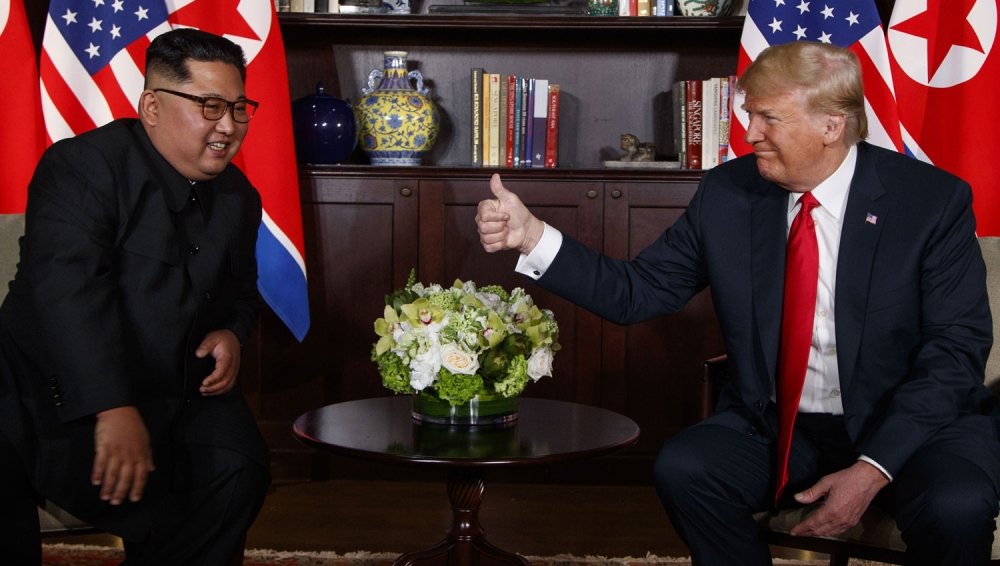
The Trump administration’s strategy toward North Korea and Iran — countries the administration has designated as “rogue” states — is at an impasse. After his June 2018 summit in Singapore with Kim Jong Un, President Trump tweeted that “there is no longer a Nuclear Threat from North Korea.” But with the Kim regime balking at its vague commitment to denuclearization, Trump will now hold a second summit with the North Korean leader in late February 2019 in the hopes of putting things back on track. In tandem, the Trump administration is pressing European allies to follow its lead and withdraw from the Iran nuclear agreement, as Trump did in May 2018, and re-impose economic sanctions to generate “maximum pressure” on the Tehran regime.
The impasse reflects a persisting tension in U.S. policy — whether the objective toward “rogue” states should be to change their regimes’ behavior or to change the regimes themselves. Should nuclear diplomacy be transactional, focused narrowly on the discrete nuclear challenge, or transformational, comprehensively addressing these regimes’ objectionable behavior? Rhetorically, with both North Korea and Iran, the Trump administration aspires for the transformational. A senior State Department official asserted, “We are trying simultaneously to pressure and to negotiate comprehensive solutions with two rogue regimes at the same time. But this very ambitiousness is a strength, not a weakness.”
The Trump administration perceives North Korea’s nuclear diplomacy as a proxy for the more fundamental question of the Kim regime’s relationship with the outside world. Pyongyang faces a double dilemma. The U.S. demand for full denuclearization would deny North Korea capabilities needed to deter what the Kim regime has long perceived as an existential external threat. At the same time, the U.S. offer of integrating autarkic North Korea into the global economy if it denuclearizes carries the regime-changing risk of political contagion.
The breadth and magnitude of changes sought in the Tehran regime’s behavior would, as one observer quipped, essentially require Iran no longer to be Iran.
The administration’s approach toward Iran is more overtly transformational. The breadth and magnitude of changes sought in the Tehran regime’s behavior would, as one observer quipped, essentially require Iran no longer to be Iran. Acquiescing to the U.S. demand that Iran become a “normal” state would entail changes in foreign and domestic policies that the Tehran views as central to its identity and the sources of its legitimacy.
The Trump administration’s eschewal of the transactional in favor of the transformational precipitated its withdrawal from the Iran nuclear agreement, which Trump has often called “the worst deal ever.” The Joint Comprehensive Plan of Action (JCPOA), concluded between Iran and the world’s major powers in July 2015 and endorsed by the UN Security Council, constrained Iran’s nuclear aspirations by blocking its access to weapons-usable fissile materials. The goal was to keep Iran’s latent capability latent. The JCPOA was quintessentially transactional — a deal focused exclusively on Iran’s nuclear challenge, not a grand bargain encompassing other objectionable aspects of Iranian behavior, such as the Tehran regime’s destabilizing regional policies and human rights abuses. The Obama administration had made the pragmatic determination that expanding the scope of negotiations beyond the urgent nuclear challenge would have scuttled the chance for success.
For U.S. opponents calling for a “better deal,” the crux of their criticism was that the transactional JCPOA was not transformational — that it constrained but did not eliminate Iran’s nuclear infrastructure and failed to address Iran’s malign behavior outside the four corners of the deal. Critics also argued that Obama’s transactional deal belied a naïve transformational bet — that over its duration, the nuclear agreement would promote the evolution of Iran into an ordinary state. When withdrawing from the JCPOA, the Trump administration embraced an agenda for immediate transformational change. Secretary of State Mike Pompeo laid out “12 very basic requirements” for “a new deal” with Iran that ranged from the dismantling of its uranium enrichment program and a cessation of missile tests to the withdrawal of Iran’s Revolutionary Guards from Syria and the ending of the regime’s longstanding support for Hezbollah. Though the administration denied that its objective was regime change, meeting Pompeo’s parameters would essentially require a change of regime in Tehran.
With North Korea, the Trump administration also opted for the transformational over the transactional. When President Trump was inaugurated, North Korea was on the verge of a strategic breakout — both quantitatively (by ramping up its warhead numbers) and qualitatively (through mastery of warhead miniaturization and long-range ballistic missiles) — that directly threatened the U.S. homeland. Unclassified projections of North Korea’s nuclear arsenal made at the time estimated that by 2020 Pyongyang could possess as many as 100 warheads. North Korea crossed the nuclear weapons threshold in 2006 and posed a direct threat to South Korea and Japan. The new factor, which precipitated the current crisis with North Korea, is U.S. vulnerability to nuclear attack. President Trump tweeted, “It won't happen,” signaling that the United States would not permit North Korea to acquire weapons that could reach across the Pacific.
In 2017, the crisis with North Korea sharply escalated. This was undergirded by inflammatory rhetoric, as Trump characterized Kim Jong Un a “madman” and North Korean state media called the U.S. president a “dotard.” The crisis was further exacerbated by an accelerated tempo of North Korean testing in 2017 — 23 ballistic missile launches and a high-yield nuclear detonation, which Pyongyang claimed was a hydrogen bomb—to which Trump responded with a threat of “fire and fury.” Then-CIA Director Pompeo, highlighting the linkage between military capabilities and regime type in the administration’s definition of threat, observed that “the thing that is most dangerous” about North Korea’s advancing nuclear and missile capabilities is “the character who holds the control over them today.”
After the U.S-led wars of regime change in Iraq in 2003 and Libya in 2011, zero nuclear warheads will simply not be on the table as long as the Kim family rules in Pyongyang.
The surprise Singapore summit in June 2018 changed the psychology of the nuclear crisis with North Korea. The initiation of a diplomatic track pushed off consideration of a U.S. military option. Though the meeting yielded a joint statement in which the Kim regime pledged its commitment to “denuclearization” of the Korean peninsula, North Korea and the United States have contending definitions of denuclearization. For Pyongyang, denuclearization would essentially require the end of the U.S. nuclear umbrella for South Korea and Japan, as well as the end of the bilateral security agreement between Washington and Seoul. For Washington, it entails the transformational goal of “CVID — complete, verifiable, irreversible denuclearization,” or what National Security Adviser John Bolton described as the “Libya model” of wholly dismantling its nuclear infrastructure under U.S. supervision as Muammar Qaddafi did in 2003.
But after the U.S-led wars of regime change in Iraq in 2003 and Libya in 2011, zero nuclear warheads will simply not be on the table as long as the Kim family rules in Pyongyang. As CIA Director Gina Haspel observed, North Korea values its nuclear deterrent “as essential to … regime survival.” In tandem with its deterrent function, the nuclear program is the North’s sole bargaining chip—an asset to monetize through negotiations with the United States and South Korea.
Nuclear diplomacy with both North Korea and Iran is at an inflection point, at which the limits of the transformational approach are evident. In his annual New Year's address, Kim Jong Un warned that North Korea would seek “new ways” to protect its interests if the United States continued “sanctions and pressures” to impose its conception of denuclearization on the North.
With Iran, the Trump administration’s coercive threat to impose extraterritorial (so-called “secondary”) sanctions on foreign commercial entities doing business in Iran has bred the resentment of the European Union, which passed a blocking statute requiring EU companies not to comply. If the unfolding U.S. policy of “maximum pressure” denies Iran any economic benefit from the nuclear deal, the Tehran regime could reevaluate its continued observance of the JCPOA. But with no immediate strategic imperative to withdraw, Iran has instead opted to stay in the agreement — letting the United States face international criticism for unilaterally jettisoning it, and plausibly reasoning that the Tehran regime can wait out the Trump administration.
The current transformational approach relies on maximalist goals that cannot be attained short of regime change; what is necessary and more plausible is a transactional strategy with discrete, limited objectives.
The Trump administration should pivot from a transformational strategy to the transactional. The current transformational approach relies on maximalist goals that cannot be attained short of regime change; what is necessary and more plausible is a transactional strategy with discrete, limited objectives. This would decouple the urgent nuclear challenge from the indeterminate question of regime change.
With North Korea, when zero is not on the table, 20 warheads are better than 100. The larger the arsenal the greater the potential risk that the chronically cash-strapped Kim regime could sell weapons-grade material to Iran, Pakistan, or even a non-state terrorist group. The near-term U.S. diplomatic objective should be to prevent North Korea’s quantitative and qualitative breakout by codifying North Korea’s current moratorium on nuclear and missile testing. Such a freeze would preclude the additional testing North Korea needs to master the complex integrated technologies to target the U.S. homeland. While Kim Jong Un has claimed that North Korea has stopped the production of nuclear weapons, a key goal of transactional diplomacy would be more fundamental—the verified cessation of the production of weapons-usable fissile materials. The price for these steps would be some U.S. sanctions relief. The U.S. narrative would be that a freeze agreement is an incremental step toward the long-term goal of denuclearization. But such a freeze would complicate U.S. alliance relationships as South Korea and Japan would continue to live under a North Korean nuclear shadow.
With Iran, the Trump administration’s return to transactional diplomacy would entail establishing priorities among Pompeo’s 12 parameters. Some, such as the complete cessation of uranium enrichment, for which the George W. Bush administration unsuccessfully pushed without international support, will not plausibly be accepted by the Tehran regime. But others could conceivably be integrated into a new, broader deal — a JCPOA Plus, so to speak. Indeed, the negotiators of the Iran nuclear deal never envisioned it as a stand-alone agreement but rather a precedent leading to follow-on negotiations on other discrete issues. For example, the Iranians were once open to negotiated range limits on ballistic missiles, which would deny them an intercontinental capability.
Diplomacy is an optimizing, not a maximizing, function. Neither North Korea nor Iran will accept a transformational U.S. negotiating position that they regard as tantamount to regime suicide. Transactional diplomacy offers a plausible pathway for constraining, not eliminating, these states’ threatening capabilities. Moreover, a discrete focus based on countering behavior that violates established international norm will garner broader international support to amplify U.S. pressure on the Pyongyang and Tehran regimes. In short, transactional diplomacy makes the best of a bad situation. The open question is whether the current impasse will lead the Trump administration to navigate this transition from the transformational to the transactional.
This article was originally published on Lawfare.
About the Author


Hyundai Motor-Korea Foundation Center for Korean History and Public Policy
The Center for Korean History and Public Policy was established in 2015 with the generous support of the Hyundai Motor Company and the Korea Foundation to provide a coherent, long-term platform for improving historical understanding of Korea and informing the public policy debate on the Korean peninsula in the United States and beyond. Read more
